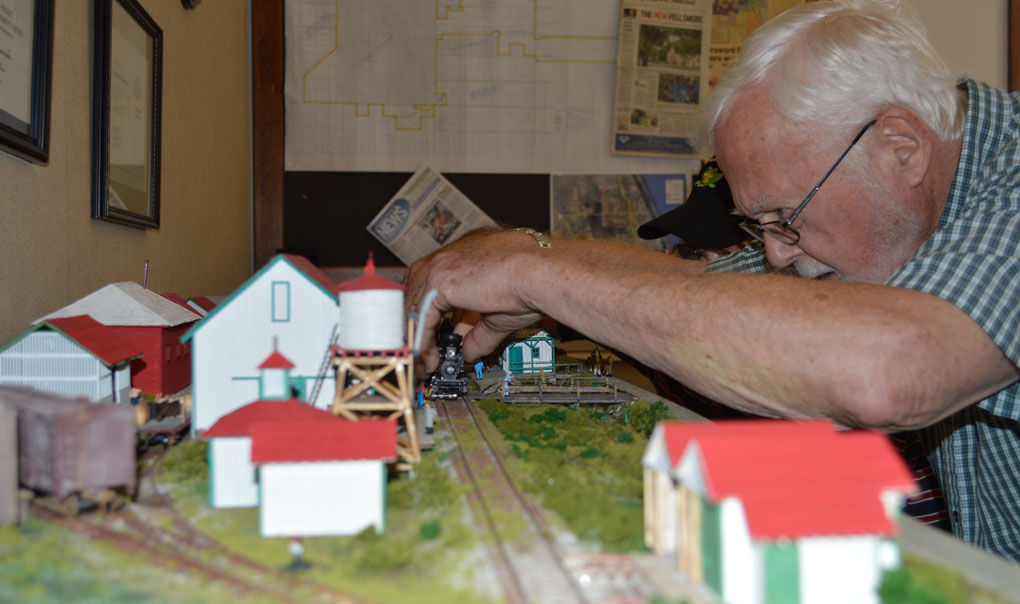FELLSMERE – Nat Huggins kept a watchful eye as the culmination of his last nine months of extremely detailed model work was carried carefully up the stairs of City Hall in Fellsmere.
The 8 feet by 2 feet model, which includes approximately 18 buildings, a handful of railroad cars on tracks, dozens of people, six dogs, and two cats, depicts the City of Fellsmere as it stood circa 1920.
Today, the only building of those featured in Huggins’ model that still stands is the foreman’s house. But the City has already begun pursuing grants to build a historical village based off of Huggins’ model for the public to enjoy.
Huggins has poured decades of his life into creating models by hand, but the Fellsmere project was particularly difficult because of its lack of good blueprints, he said.
“The only thing we had to go on were photos,” Huggins said. “And a few footprints” drawn up by a civil engineer almost 100 years ago. But those footprints only allowed for the foundational dimensions.
Much of Huggins’ time was spent agonizing over historical dimensions: height, depth, and details of buildings that were knocked down long ago.
Local historians and supporters of the project Clarence “Korky” Korker, Rich Votapka, and “Caboose” Mikey Starck were on hand to explain the value the model brings to the city.
“We want to get a railway village rebuilt in Fellsmere,” Votapka said. “All of these buildings (in the model) existed more than 100 years ago.”
The details in Huggins’ model, Votapka explained, not only give an accurate visual of historic Fellsmere, but it gives the City an invaluable model of what the new railway village will actually look like once its rebuilt.
“We took Nat out to the existing building, and we scraped down through layers of paint to find the exact green that was painted on the trim,” Starck said. “We knew the buildings were white with green trim and red roofs, but Nat wanted to know exactly what shade of green.”
“I actually had a bottle of green paint that was a dead ringer for it,” Huggins said. “But I’m all out of it now, so there can be no additions made to this model!” he teased.
But finding the right green paint was only one of hundreds of minor details Huggins worked into the project. For instance, he added ice blocks on the back deck of the ice plant, handmade all of hand operated railroad switches because he couldn’t find a model he liked, and cut every tiny decal letter himself to add to the train engines and depot.
The tomato packing plant, power plant, train station, water tank, and every other building, Huggins had a story behind the craftsmanship of each.
He even told of two miniature prisoners strategically placed inside the model jail. Even though no one else can see them in the building, he knows they are there.
“I estimate it took significantly longer” than 500 hours, Huggins said.
But the City of Fellsmere is appreciative of every last hour of work.
Fellsmere has already secured a Recreational Trails Program (RTP) grant to fund the rails to trails path through the village. It has also successfully preserved the existing foreman’s house and is actively applying for grants to fund the rest of the buildings.
According to Fellsmere City Manager Jason Nunemaker, it’s the persistence and hard work of locals who are proud of Fellsmere’s history and dedicated to preserving it who have propelled the project forward so quickly.
He said he hopes the model will be proof to the Division of Historical Resources of the City’s dedication to rebuilding a historical village in Fellsmere; a dedication that will lead to more grants for the project.
The historical village, Nunemaker said will be finished within 10 years.
“But as fast as things have been moving, it could be as soon as five years,” Nunemaker said.
Within a matter of days after finishing the model, Huggins injured his hand in an unrelated accident and is barely able to deliver a proper handshake, much less build, glue, and paint miniature buildings and trains, Huggins said.
But as soon as he heals, he’s ready to get back to building his model version of the Charles W. Morgan, a whaling ship built in 1841 that is still docked at Mystic Seaport in Connecticut today.
His Fellsmere model will be on display in City Hall as soon as the protective glass case arrives.

